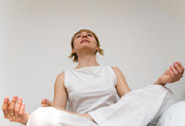Yoga Styles
 The practice of yoga dates back centuries to ancient India. Although still very popular in Eastern cultures, yoga has become a world-wide practice, and gains new followers on a regular basis. Because yoga is approximately 5000 years old, the practice has branched out to suit the needs of the many different types of people that do yoga. There is a common goal of happiness and well-being among all branches of yoga, but techniques vary from practice to practice.
The practice of yoga dates back centuries to ancient India. Although still very popular in Eastern cultures, yoga has become a world-wide practice, and gains new followers on a regular basis. Because yoga is approximately 5000 years old, the practice has branched out to suit the needs of the many different types of people that do yoga. There is a common goal of happiness and well-being among all branches of yoga, but techniques vary from practice to practice.
Hatha Yoga, meaning Sun-Moon yoga, is the most common type of yoga that consists of poses and breathing techniques. In Hatha Yoga, it is believed that the body acts out what the spirit cannot. From Hatha Yoga came Bikram Yoga, Ashtanga Yoga, Power Yoga, and Kundalini Yoga. Hatha Yoga balances the positive (sun) with the negative (moon).
Kundalini Yoga is aimed at summoning a serpent spirit that resides in the base of the spine called Kundalini. The snake is in a curved position, and by straightening the back the creature can travel the length of all the vertebrae and to the brain for awareness. In modern yoga, this form is considered the most powerful by some. Kundalini literally translates to “coiled up” in Sanskrit.
Bikram Yoga, after the originator of the practice, Bikram Choudhury. This type of yoga is performed in a heated room – usually ninety to one hundred degrees Fahrenheit – and is a set of twenty-six different poses that are done twice for specific amounts of time. The heat helps to allow one to do the poses more safely and efficiently.
Ashtanga Yoga translates into eight limb yoga, and it provides a rigorous workout which is not present in all forms of yoga. There are eight different practices that make up Ashtanga Yoga; they are Yama, Niyama, Asana, Pranayama, Pratyahara, Dharana, and Dhyana. Sweating is important to cleanse the system of the body and all its functions by allowing toxins to leave the body.
Power Yoga is considered to be the Western interpretation of another form of yoga: Ashtanga Yoga. Breathing and posing are some important aspects of both forms of yoga.
Bharata Yoga is very specific in practice. Alignment of the body is crucial to increase the strength and health of the muscles, especially the deeper muscles that are difficult to reach. By doing a headstand, this alignment can be achieved, which relaxes the body. Meditation and breathing exercises are, of course, very important in Bharata Yoga.
Nude Yoga is exactly that. Some feel that clothes restrain the natural form and functions of the body. Nude Yogi practice together or alone, but many are not ashamed to be in their purest form in front of others. Nude Yoga is not meant to be a sexual experience, but a connection of the mind, body, and soul.
Cy-Yo is an hour long cardio session that consists of practicing yoga and cycling on a stationary bike. Ten minutes are spent warming up, forty are cycled away, and another ten minutes are taken to cool down after this workout. This calms the minds and bodies of Cy-Yogis.
